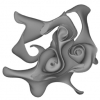Free Online Productivity Tools
i2Speak
i2Symbol
i2OCR
iTex2Img
iWeb2Print
iWeb2Shot
i2Type
iPdf2Split
iPdf2Merge
i2Bopomofo
i2Arabic
i2Style
i2Image
i2PDF
iLatex2Rtf
Sci2ools
Publication
Robust Topological Operations for Dynamic Explicit Surfaces
We present a solution to the mesh tangling problem in surface tracking. Using an explicit triangle mesh to track the location of a surface as it moves in three dimensions has many potential advantages for accuracy and efficiency, compared to implicit capturing methods such as level
sets. However, particularly when “mesh surgery” is required for topological changes, this approach is
prone to tangling: The mesh may self-intersect or otherwise no longer represent a physical interface.
Our new approach uses robust collision testing to determine when a mesh operation—such as motion,
adaptive refinement, coarsening, or topological change—will lead to an invalid state; we then either
roll back noncritical operations or apply robust collision response algorithms, minimally perturbing
the mesh to guarantee validity. We present numerical examples demonstrating the robustness and
accuracy of the method.
| Added | 17 Feb 2010 |
| Updated | 16 Jul 2010 |
| Type | Journal |
| Year | 2009 |
| Where | SISC |
| Authors | Tyson Brochu, Robert Bridson |
Comments ()


